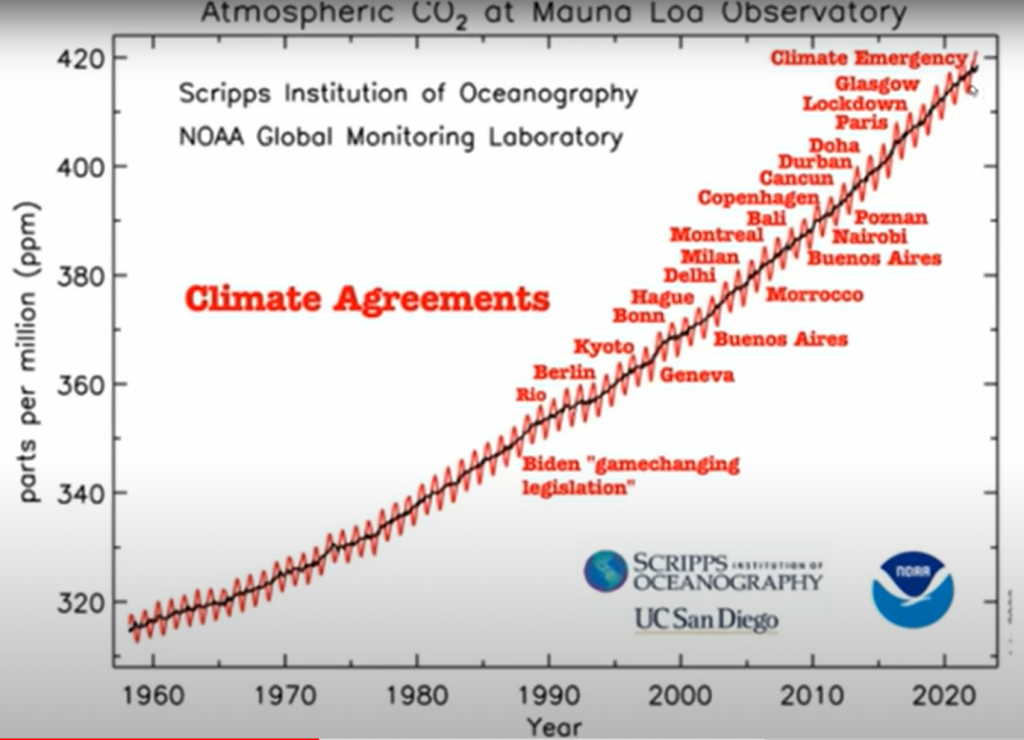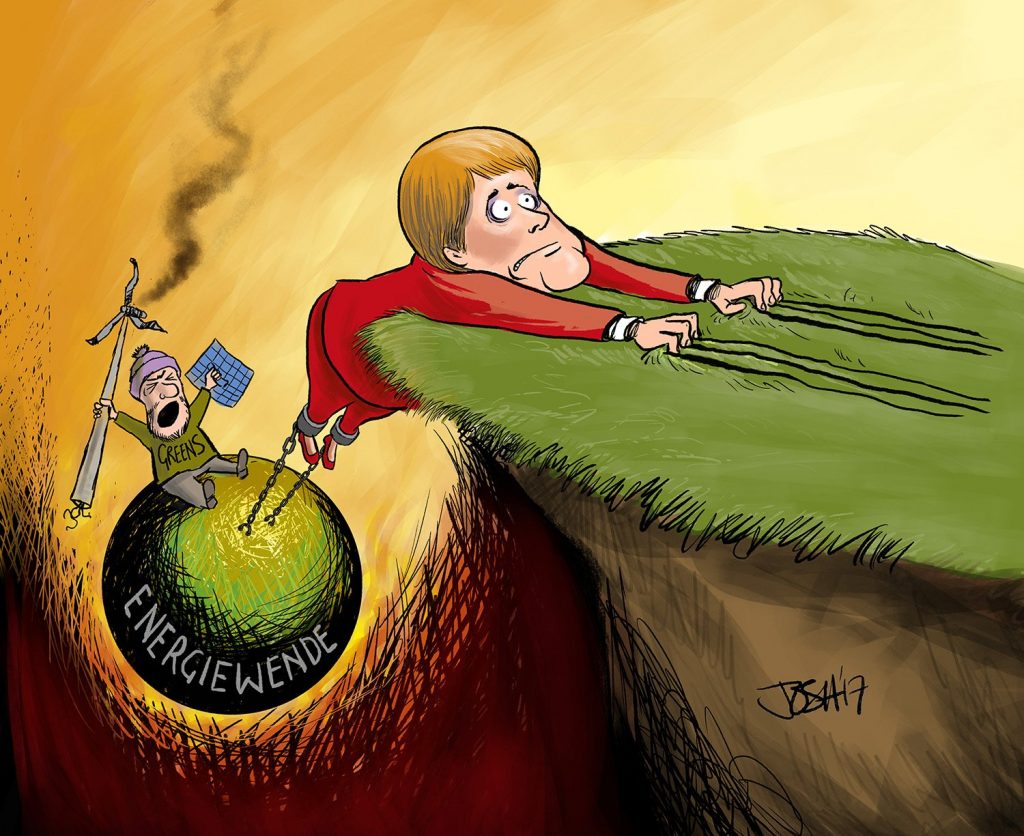YOU SHOULD SUBSCRIBE TO CLIMATE CHANGE WEEKLY.
IN THIS ISSUE:
- COP 27 Will End Up as FLOP 27
- Podcast of the Week: Data Is the Cure to Climate Change Anxiety (Guest: Rob Bradley, Jr.)
- Switzerland Mulls Power-Induced Electric Vehicle Ban
- France Reluctantly Reembraces Coal
- Offshore Wind Projects Hurt Ocean Life
- Video of the Week: Takeaways from the UN’s Climate Conference
- BONUS Video of the Week: Our Dystopian “Green” Future
- Climate Comedy
- Recommended Sites
COP 27 Will End Up as FLOP 27

The 27th Conference of the Parties (COP 27) of the United Nations Framework Convention on Climate Change has come and gone. In its aftermath, I say now what I said before: “Actions speak louder than words.”
Judging by the effect of past climate agreements on the actions of nations around the world, the agreements reached at the COP 27 meeting held in Egypt in November are probably not worth the paper they are printed on. Almost certainly the tons of emissions generated by the 20,000 or more celebrities, business elites, NGOs, politicians, and bureaucrats who attended COP 27 will be greater than any emission reductions generated by the agreements made at the conference itself.
Environmentalists were discouraged by COP 27. Going into the conference, they demanded governments make firm commitments to end the use of fossil fuels by a date certain, saying that is the only way to avert a climate catastrophe. Their demand was unrealistic to the point of being idiotic. Unsurprisingly, they did not get their way.
Before the conference, developing countries made it clear they wanted to focus on getting reparations for climate harms they claimed developed countries’ fossil fuel use had imposed on them. They wanted the developed countries to establish and finance a “loss and damage” fund. Estimates of the necessary size of the fund to compensate the developed world fully for present and future damages were in the trillions of dollars. Developed countries had long fought the idea they owed climate reparations. Instead, as I discuss below, previous COPs committed to establish a Green Climate Fund.
At the outset of COP 27, U.S. President Joe Biden signaled he was open to negotiating a “loss and damage” agreement, but only if China agreed to participate and contribute. By the end of COP 27, it became clear Biden had been bluffing, and his red line was erased as if it had never existed. Biden committed the United States to contribute to a reparations fund even though China flatly rejected participating in any other way than as a recipient of payments. You read that right: the world’s biggest emitter by far wants to be compensated for the greenhouse gas emissions its economic competitors emit. Biden agreed to that.
In the end, although the developed world agreed to finance a loss and damage fund, it is likely to end up like previous commitments: all talk and no action. The loss and damage agreement is more an agreement to agree than an actual commitment to provide money. Biden couldn’t do that if he wanted to without running it past Congress, the governing body that controls the purse strings. As The Hill points out, the agreement contains no specifics about who will provide the funds or how much the various countries will pay into it. It sets no hard deadline to establish the fund or to start the payments. It describes no mechanism for paying out the funds, how much goes to which countries, and the conditions for receiving payments.
The problem with this agreement was described aptly more than 370 years ago in Thomas Hobbes’ rightly still-discussed book Leviathan: “Covenants, without the sword, are but words and of no strength to secure a man at all.” There is no sword backing this loss and damage agreement, just as there was no sword backing any of the agreements that emerged from the previous 26 COPs.
A brief review of the history of these agreements confirms Hobbes’ insight.
In 1992, 165 countries signed the United Nations Framework Convention on Climate Change (UNFCC), agreeing to “stabilize greenhouse gas concentrations in the atmosphere.” To do so, 43 industrialized countries agreed to implement voluntary measures to stabilize their greenhouse gas emissions at 1990 levels by the year 2000. They missed that target badly. Twenty-two years after the deadline, that goal has gone unmet and carbon dioxide emissions have increased.
In 1997, parties to the UNFCC negotiated a new treaty: the Kyoto Protocol, with the same developed countries agreeing to legally binding greenhouse gas emission reductions averaging 5 percent below 1990 levels by 2012.
History repeated itself. The parties to the Kyoto Protocol missed their greenhouse gas emission reduction targets by a wide margin—with no penalties forthcoming.
In the 2015 Paris climate agreement, 196 countries agreed to cut or stabilize greenhouse gas emissions at levels necessary to prevent the Earth from warming two degrees Celsius above preindustrial levels. The U.N. estimated this would mean cutting global greenhouse gas emissions by 80 percent by 2030 and producing net-zero emissions by 2050. In the meantime, the countries set interim timetables with specific emission reduction targets.
Seven years on, no country has met its commitments, and global carbon dioxide emissions are still increasing. The Paris agreement, for all the lofty words spoken in support of it in repeated COPs since then, has not accomplished any of its goals.
Also at Paris in 2015, world governments agreed to provide $100 billion to a Green Climate Fund (GCF) each year—a fraction of what the new loss and damages agreement would require. The GCF was created to help developed countries adapt to future changes to the climate. As with the carbon dioxide emissions reductions in Paris, nations were not legally bound to fund the GCF, and in fact they have not done so. In the seven years since the GCF was established, nowhere near $100 billion in total has been provided to it, much less the $100 billion annually required by the agreement.
Despite all the emissions spewed, protests undertaken, five-star meals shared, solemn presentations made, blustery speeches given, and treaties and agreements signed, 27 COPs have produced no emission reductions. Despite a significant decline in emissions from developed countries relative to the trend in developing countries since the first treaty was signed in 1992, not only have emissions increased overall, they have increased at the rate that in 1992 was basically considered business as usual—the rate that was projected to come to pass if no one did anything at all to cut emissions (see the figure below). This happened despite the imposition of numerous regulatory restrictions and taxes on fossil fuel development and use, plus hundreds of billions of dollars being spent to transition to greener technologies.

That’s covenant without the sword, folks. Honestly, we can all be happy there is no sword, because the goals proposed in these various climate agreements would have set back the world’s economic development by decades, if not centuries. The idea of ending fossil fuel use by government fiat, when no equivalent replacement is waiting in the wings, puts me in mind of another justly famous Hobbes quote: life in such a society would be “solitary, poor, nasty, brutish, and short.” Imagine that future as the Donner Party, not the garden of Eden.
SOURCES: United Nations; The Hill
Podcast of the Week
The media loves to report on “climate change anxiety” as a serious concern. While overblown, there is some truth to this. However, the media should push blame on the true culprits, themselves.
Rob Bradley, Ph.D., the founder and chairman of the Institute for Energy Research, is a global on energy markets. Bradley argues that the false narrative of an impending climate crisis perpetuated by certain politicians and the corporate media is creating climate anxiety. This isn’t a problem with climate change. It’s a problem with pushing false narratives. Data easily refutes it.
Rob Bradley explains that attending the 15th International Climate on Climate Change February in Orlando should alleviate any anxiety or fear anyone has about the dangers of climate change. It is bad climate policies that we should truly fear.
Subscribe to the Environment & Climate News podcast on Apple Podcasts, iHeart, Spotify or wherever you get your podcasts. And be sure to leave a positive review!
Get your Copy at Amazon TODAY!
Switzerland Mulls Power-Induced Electric Vehicle Ban

The Swiss government, like other European governments, has pushed the replacement of vehicles powered by internal combustion engines with electric vehicles as a way of reducing greenhouse gas emissions and meeting the nation’s carbon dioxide reduction commitments.
Unlike in most nations, this would reduce emissions from Switzerland because transportation is the largest source of Switzerland’s emissions. Switzerland’s electric power supply comes almost entirely from renewables (a little over 70 percent) and nuclear (28.9 percent). Hydropower by itself, long a mainstay of Switzerland’s power grid, accounts for 87 percent of the renewable electric power generated, with solar, wind, and biomass and waste incineration accounting for the remaining renewable power.
Despite this, the Swiss government is now considering banning the use of electric vehicles for “nonessential” purposes. No pleasure trips or holiday outings, no visits to friends or relatives for electric vehicle owners. Switzerland’s electric power supplies are tight, and using electric vehicles, which of course requires charging them, is to be discouraged in order to avoid “load shedding,” meaning planned outages for specific customers or neighborhoods.
Breitbart notes other electric power saving laws are being considered: “limiting the total speed of cars, reducing the opening hours of shops as well as the amount of heating permitted at nightclubs.”
The Swiss government, like the leaders of other European nation, is blaming lack of access to Russian gas. That claim rings hollow. Although Switzerland did rely on Russian imports for approximately 43 percent of the natural gas it used before the Ukraine invasion, almost all of that gas is for home heating or industrial and commercial uses. All fossil fuels combined have fallen to almost zero as a source of electricity at present, decreasing from the miniscule 2.5 percent of the electricity they supplied in 2013. Switzerland does not have a single gas power plant devoted full-time to electric power, and it closed its sole oil-powered plant (associated with a now-defunct refinery) in 1999.
If not Russia, what caused the shortfall in Swiss electric power? The answer: increasing electric power demand from Switzerland’s push to decarbonize transportation emissions, combined with greater reliance on intermittent solar power and the recent closure of some nuclear power plants after the Fukushima accident in Japan (and other nuclear closures in the works). In short, politically forced increases in electricity demand and politically required supply reductions are creating the electricity shortfall.
Switzerland’s obsession with cutting emissions—not inherent power supply weaknesses, Russia’s Ukraine invasion, or climate change—is threatening the Swiss people’s standard of living and their ability to travel when, where, and for whatever reason they want.
France Reluctantly Reembraces Coal

The Associated Press is reporting that France, where nuclear power has long been the most significant source of electric power, is keeping a coal plant open beyond its planned date of closure and reopening a second coal-fueled power plant that was closed to much fanfare earlier this year.
France had been phasing out coal use for decades as its nuclear fleet grew, and hydropower is the second-largest source of electric power there. French President Emmanuel Macron had vowed to close all coal-burning plants in the country by the end of 2022, as part of the country’s effort to fight climate change.
With huge government subsidies and power purchase mandates, wind and solar grew from providing almost no power to the electric grid in 2004 to approximately 8.4 percent today. Natural gas displaced coal as the largest source of fossil fuel generated power over the past three decades and is now the third largest source of power—which is fine as long as France has access to gas. France relied on Russia for much of its gas supply, however, so in the aftermath of the Ukraine invasion, France’s access to Russian gas has been compromised. Other countries that supply France with natural gas can’t take up the slack because of their own demand and limited spare pipeline and tanker/LNG terminal capacity.
The result, as reported by the Associated Press:
The end of France’s coal era seemed so certain last year that the operator of one of the country’s last coal-burning plants posted an upbeat educational video on YouTube titled “Let’s visit a coal plant that’s going to be destroyed!”
The plant in the northeastern town of Saint-Avold indeed halted coal production as scheduled earlier this year—but not for long. This week, its workers were back at the controls, transporting coal from storage heaps and refiring furnaces, as part of emergency efforts to keep the heat and electricity on this winter. …
Facing a worst-case scenario of rolling power cuts to households, the government issued a decree in September to allow Saint-Avold to start again and continued activity at another coal plant in western France, citing the “exceptional” and “unforeseeable” context of energy supply challenges.
Those involved in the restart and operation of the plant have called it a “necessary evil” for the medium term.
Macron has pushed to make France the global leader in fighting climate change, telling the U.S. Congress in a speech in 2018, “[W]e are killing our planet. Let us face it. There is no planet B.”
One question. If the state of the planet is so dire, why not just take the hit and tell the French people that living with less and at times no power is a “necessary evil” if they are to save the planet from a catastrophe caused by greenhouse gas emissions? France could have a “climate lockdown” like what it did two years ago with COVID.
That’s not the path Macron is taking. Hypocrisy is always rife in government. When push comes to shove, politicians realize people want their electric power, climate change be damned.
SOURCE: ABC News/Associated Press
Heartland’s Must-read Climate Sites
Offshore Wind Projects Hurt Ocean Life
A recent study published in the peer-reviewed journal Nature Communications found offshore wind industrial facilities do previously unrecognized harm to marine ecosystems.
A team of scientists from various German research institutes and universities examined industrial wind projects in the North Sea, where the world’s largest offshore wind project is found.
Running multiple simulations through mathematical models, the scientists analyzed the “systematic, large-scale, time-integrated response of the ocean to large OWF [offshore wind farm] clusters,” concluding the “results provide evidence that the ongoing off shore wind farm developments can have a substantial impact on the structuring of coastal marine ecosystems on basin scales.”
The model simulations indicate the “wind wake” effect of OWFs (the effect turbines individually and collectively have on wind speeds, ocean currents, and sea life) could reduce annual primary productivity—the ability of microbial life, algae, phytoplankton, plants, and animals to obtain food and flourish—in the area encompassed by and beyond the wind farms by 10 percent or more. Less food for endangered whales and other ocean creatures is not a good thing.
The same modeling indicates OWFs slow ocean currents, resulting in less cycling of dissolved oxygen in affected areas and thereby reducing oxygen concentrations. Lower oxygen levels are bad for marine life.
Separately, these negative effects on the marine ecosystem in OWF areas indicate the OWFs will harm many species and disrupt ecosystem interconnections. Cumulatively, the harm will probably be much greater, including making it harder for endangered species such as the North Atlantic right whale to recover or even survive.
SOURCES: Townhall; Nature Communications
Takeaways from the UN’s Climate Conference
The United Nations’ COP27 climate change summit has concluded, bringing another year of doomsday predictions, destructive policy promises, and a sharp uptick in private jet use. As the 27th summit, one may expect that delegates would stop sounding the alarm as predictions prove false again and again. Instead, we’re left with promises of climate reparations and claims of unprecedented weather events.
However, developing nations have switched course. Many argued that they should be allowed the freedom to use fossil fuels to lift their citizens out of poverty rather than rely on developed nations that promise infrastructure for renewables but never deliver it. Andy Singer, Anthony Watts, Linnea Lueken, and H. Sterling Burnett break COP27 down on this episode of Climate Change Roundtable.
Tune in LIVE every Friday at noon CT on YouTube to catch the show and participate with other fans in the chat.
Our Dystopian “Green” Future
The Heartland Institute’s Donald Kendal, Jim Lakely, Justin Haskins, and Chris Talgo present episode 375 of the In The Tank Podcast. Recently, there has been a wave of stories coming out that paint a pretty bleak picture of our “green” future.
From high energy prices and energy shortages to dictates about how you should live your life and whether you should have kids, climate alarmists seem to have no shortage of bad ideas. The ITT crew talks about these stories and more.
Tune in LIVE every Thursday at noon CT on YouTube to catch the show and participate with other fans in the chat.
Climate Comedy
 via Cartoons by Josh
via Cartoons by Josh




























